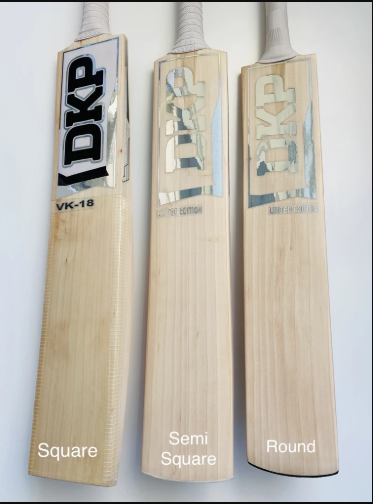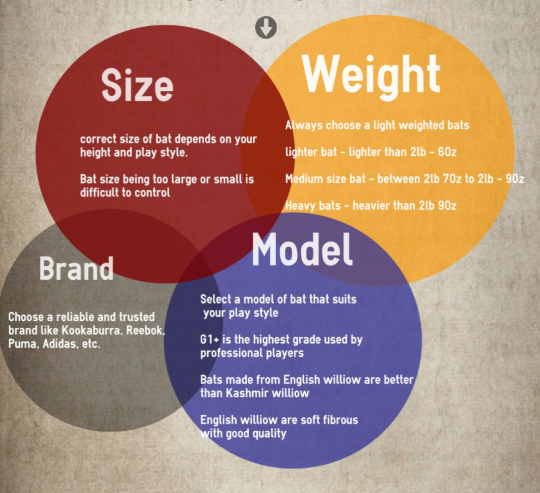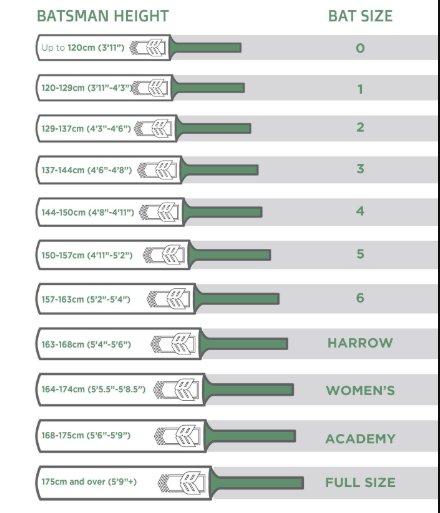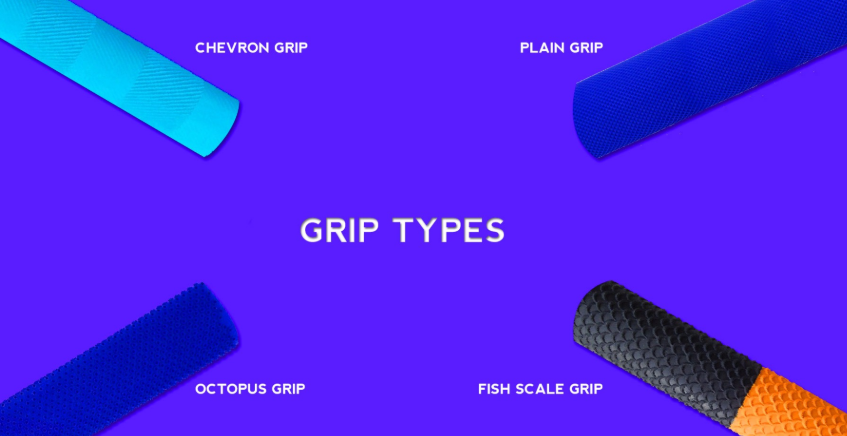A large variety of cricket bats are manufactured in various sizes based on modern science and usage. Buying a proper cricket bat based on its size plays an important role in picking the best professional cricket bat. As far as cricket is concerned the Bat used by the player plays a vital role in the game.
The professional cricket bats are manufactured using the willow wood. The size of the cricket bat is an important factor to look after while buying a perfect willow wood striker.
Major Types of Cricket Bats
Cricket bats can be divided based on time such as Modern cricket bat and Traditional cricket bat.
Traditional cricket Bat
Traditional cricket bat has round toe bottom, round edge, concave back profile. Concaving is more evident in traditional bats and is done to reduce the bat’s weight while still providing thicker edges and deeper swells, thereby improving its pick-up. Cricket Bats with concave back profiles are those that have had wood scooped out from either side of the bat’s spine.
Modern cricket Bat
Modern cricket Bat has flat toe bottom, sharp edge and filled back profile. Some profiles have filled backs with little to no concaving. Modern bats still come with traditional profile as rounded toe, rounded edge and concave back profile. You can see the above image where both are examples of modern cricket bat profiles.

How to buy a perfect cricket bat
Being in-the-know with cricket bat sizes and selecting the right one is one of the most important purchasing decisions when it comes to buying a cricket bat.
Choosing the correct cricket bat size is of paramount importance because it heavily impacts on the way you play, your freedom of movement and your range of shots. There are also some health and safety factors to take into account.

It is important that the bat is not too long and more importantly not too heavy to hinder correct stroke play and good technique. Junior bats are scaled-down in size and weight to meet this important requirement. Below is an accurate guide to help you buy an accurate size for a junior cricketer.
Cricket bat size chart
| BAT SIZE | APPROX. AGE | HEIGHT OF BATSMAN | BAT LENGTH | BAT WIDTH |
| 1 | 4-5 Years Old | Up to 4ft 3inches | 25 1/4 inches | 3 1/2 inches |
| 2 | 6-7 Years Old | 4ft 3″ – 4ft 6″ | 27 3/4 inches | 3 1/2 inches |
| 3 | 8-9 Years Old | 4ft 6″ – 4ft 9″ | 28 3/4 inches | 3 3/4 inches |
| 4 | 9-10 Years Old | 4ft 9″ – 4ft 11″ | 29 3/4 inches | 3 3/4 inches |
| 5 | 10-11 Years Old | 4ft 11″ – 5ft 2″ | 30 3/4 inches | 4 inches |
| 6 | 11-13 Years Old | 5ft 2″ – 5ft 5″ | 31 3/4 inches | 4 inches |
| HARROW | 12-14 Years Old | 5ft 5″ – 5ft 8″ | 32 3/4 inches | 4 1/6 inches |
| FULL SIZE (Short Handle) | 15+ Years Old | 5ft 8″ – 6ft 3″ | 33 1/2 inches | 4 1/4 inches |
| FULL SIZE (Long Handle/Blade) | 15+Years Old | 6ft 3″ and above | 34 3/8 inches | 4 1/4 inches |
PLEASE NOTE – The above details are an approximation only.
Cricket Bat Height
This should be the primary consideration when buying a cricket bat. Cricket bats come in different sizes for obvious reasons. The most important factor while choosing a particular size is the age and height of the person using them. Buying the right bat is very important for a young player’s growth.
Similarly, a professional player should also buy an optimum bat according to his style and height. The sizes available in a cricket bat are size 0 to 6 for junior players. While for seniors and professional players bats categorized as Harrow, Short Handle, and Long Handle are available. A brief description of these is given below.

Looking beyond cricket bat size, one should also focus on bat’s design in terms of dimensions and grip used in it. Times of Sports explained both the terms in-depth to buy the suitable cricket bat.
Cricket Bat Dimensions
Law 5 of the Laws of Cricket state that the length of the bat may be no more than 38 in (965 mm), the width no more than 4.25 in (108 mm), the overall depth no more than 2.64 in (67 mm) and edge no more than 1.56 in (40 mm). Bats typically weigh from 2 lb 7 oz to 3 lb (1.2 to 1.4 kg).
Choosing a suitable weight for the bat also plays an important role. You don’t want a bat which is too heavy or too light as this will ultimately affect how well you play. This is especially important for juniors.
Because the biggest bat won’t necessarily make you hit the ball further if you aren’t strong enough to play your shots correctly. Consequently, a bat which is too light may hinder your potential. This is why it’s better to focus on the pickup of a bat rather than weight.
Cricket Bat Grip Types
Bat Grips are found over the handle of the cricket bat. Cricket bat grips are made of rubber and composites. Cricket bat grips come in different varieties based on design patterns. Some of the cricket bat grips include chevron cricket bat grip, zigzag cricket bat grip, Plain cricket bat grip, dynamic bat grip, octopus cricket bat grip and fish scale cricket bat grip.
Cricket Bat Grips is essential for the overall feel of a cricket bat and allows the batsman to have full control of the blade. It allows the batsman to have full control of the blade. Therefore, it is important for a batsman to change his cricket bat grip from time to time when there are obvious signs of wear and tear.

Chevron or zigzag grip
This is probably the most go to Grip for any batsman when in doubt. A Chevron Grip Can Never Go Wrong For Any Batsman Whatever may be the Playing Style. Very Soft on the Hands and gives optimum manoeuvrability to smash it to all corners of the park.
Octopus grip
This type of grip is widely known for its gripping texture. The Pores in the Texture kind of create a Vacuum with the gloves and give unmatched gripping. It also increases the grip between glove and bat and reduces the chances of slipping from the bat. On the Other hand, some players complain that it’s a Bit Harsh on the Gloves as it slightly reduces the durability of gloves.
Fish scale grip
One of the most popular grips. Also known as half-moon grip. Provides excellent feel and grip.
Plain or Diamond grip
Diagonal gloves create a surface resembling thousands of diamonds. The texture is relatively flat and is the original cricket bat grip texture.
Aqua Wave
Alternating half-moons creates a texture that resembles wave ripples. Due to the dye construct, this is a good texture for three and four colour grips as there is little bleeding of colours (octopus still recommended if minimal bleeding is vital).
Heaviest Bat Cricketers Used
- LANCE KLUSENER – 1470–1500 gms
- CHRIS GAYLE – 1360–1380 gms
- ANDRE RUSSEL – 1350–1360 gms
- SACHIN TENDULKAR – 1350 gms(max)
- MS DHONI – 1280–1300 gms
- DAVID WARNER – 1300 gms(max)

